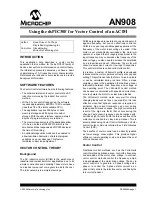
AN908
DS00908A-page 6
2004 Microchip Technology Inc.
Space Vector Modulation
The final step in the vector control process is to gener-
ate pulse-width-modulation signals for the 3-phase
motor voltage signals. By using Space Vector Modula-
tion (SVM) techniques the process of generating the
pulse width for each of the 3 phases reduces to a few
simple equations. In this implementation the Inverse
Clarke Transform has been folded into the SVM
routine, which further simplifies the calculations.
Each of the three inverter outputs can be in one of two
states. The inverter output can be either connected to
the + bus rail or the – bus rail, which allows for 2
3
=8
possible states that the output can be in (see Table 1).
The two states where all three outputs are connected
to either the + bus or the – bus are considered null
states because there is no line-to-line voltage across
any of the phases. These are plotted at the origin of the
SVM Star. The remaining six states are represented as
vectors with 60 degree rotation between each state, as
shown in Figure 7.
FIGURE 7:
SPACE VECTOR
MODULATION
The process of Space Vector Modulation allows the
representation of any resultant vector by the sum of the
components of the two adjacent vectors. In Figure 8,
UOUT is the desired resultant. It lies in the sector
between U60 and U0. If during a given PWM period T
U0 is output for T1/T and U60 is output for T2/T, the
average for the period will be UOUT.
FIGURE 8:
AVERAGE SPACE VECTOR
MODULATION
The values for T1 and T2 can be extracted with no extra
calculations by using a modified Inverse Clark transfor-
mation. By reversing v
α
and v
β
, a reference axis is
generated that is shifted by 30 degrees from the SVM
star. As a result, for each of the six segments one axis
is exactly opposite that segment and the other two axis
symmetrically bound the segment. The values of the
vector components along those two bounding axis are
equal to T1 and T2. See the CalcRef.s and SVGen.s
files in
for details of the
calculations.
You can see from Figure 9 that for the PWM period T,
the vector T1 is output for T1/T and the vector T2 is
output for T2/T. During the remaining time the null vec-
tors are output. The dsPIC
®
device is configured for
center aligned PWM, which forces symmetry about the
center of the period. This configuration produces two
pulses line-to-line during each period. The effective
switching frequency is doubled, reducing the ripple
current while not increasing the switching losses in the
power devices.
TABLE 1:
SPACE VECTOR MODULATION INVERTER STATES
U60(011)
U120(010)
U180(110)
U(111)
U(000)
U0(001)
U240(100)
U300(101)
U60(011)
U
OUT
T2/T * U60
T1/T * U0 U0(001)
T = T1 + T2 + T0 = PWM Period
U
OUT
= T1 * U0 + T2 * U60
T
C
B
A
V
ab
V
bc
V
ca
V
ds
V
qs
Vector
0
0
0
0
0
0
0
0
U(000)
0
0
1
V
DC
0
-V
DC
2/3V
DC
0
U
0
0
1
1
0
V
DC
-V
DC
V
DC
/3
V
DC
/3
U
60
0
1
0
-V
DC
V
DC
0
-V
DC
/3
V
DC
/3
U
120
1
1
0
-V
DC
0
V
DC
-2V
DC
/3
0
U
180
1
0
0
0
-V
DC
V
DC
-V
DC
/3
- V
DC
/3
U
240
1
0
1
V
DC
-V
DC
0
V
DC
/3
- V
DC
/3
U
300
1
1
1
0
0
0
0
0
U(111)





















